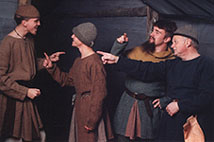Meet the Middle Ages
BackThe Peasants

During late Iron Age, only parts of the country were populated. There are Iron Age burial fields in the river valleys. The greater part of the region was uninhabited. During the early Middle Ages, there was a period of expansion. New land was cleared in the wooded in-lands. In the old populated regions, there were villages, but the farmers who established themselves in the forests, lived on single farms. Place-names with –ryd ( cleared land), -hult (meadow) and –måla (claimed territory) indicate such settlements.
The clearing of new land continued until the second half of the 14th century. In the summer of 1350, the plague (the so-called Black Death) struck Kalmar and by autumn it had reached the forests of Aspeland. The effects of the plague were very severe, particularly so in areas with a small population. There was a decrease in farming during the latter part of the 14th and first part of the 15th century. Agriculture did not pick up until the end of the 15th century, because the plague struck time and time again; in 1363-66, in 1393-99, in 1404-06 and in 1411-16.
Many of the Aspeland farmers had their own property and paid taxes to the crown. They were free-holders – "skattebönder". The gentry owned land and property , and the farmers who farmed this land were tenant farmers –" frälsebönder". They leased the farm from the nobleman and paid taxes to him. The lease would usually be renewed every six years. When the lease was up for renewal, an additional fee was often claimed. It might have been rather more troublesome to have been a tenant farmer than a free-holder. The church, the bishop and the convents were land-owners, too. Their tenant farmers were called church- bishop- or convent-farmers. During the 15th century, many farms in Aspeland belonged to the convent at Vadstena. The bailiff from the convent came to collect the taxes, and to make sure that everything was properly managed.
The peasants in the valley of the Emå River made their living from keeping livestock and growing crops. They had fields of barley, rye or flax, as well as cattle. In the woods, the farmers would make an additional living from forestry, charcoal-burning and tar-making . Above all, they produced iron. Plenty of iron was produced during the 13th and 14th centuries. At this time, the largest production of iron in northern Europe, lay in Madesjö-Bäckebo and Gullabo-Karlslunda. There was iron production on a large scale in Aspeland as well.
The iron would be loaded on horses or carts, and taken to Vimmerby or to the port at Figeholm. It may also have been brought straight to Kalmar by horse or by cart. In any case, the iron was taken from Figeholm to Kalmar and was then shipped south to towns in northern Germany.
Idag ser vi spår efter dem inte minst genom de många slagghögarna, slaggvarparna.
We can see remnants of the iron-producing farmers´ work in the so-called slag-heaps – "slaggvarpar".